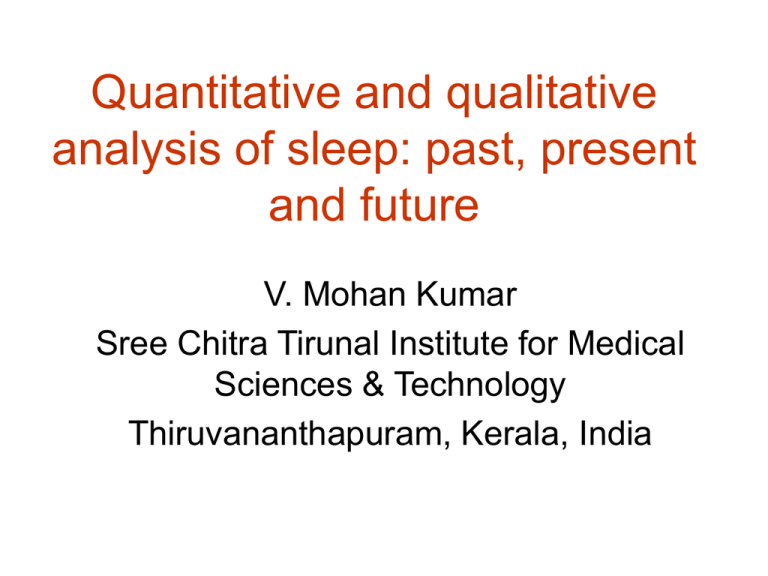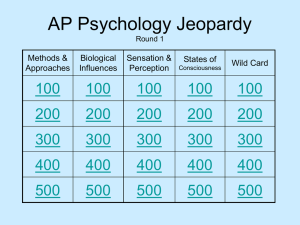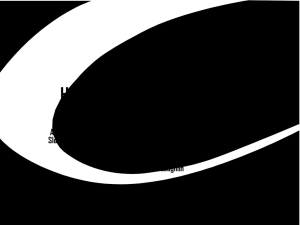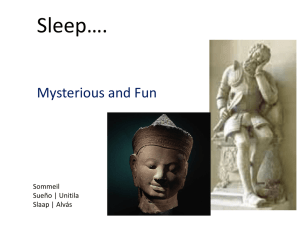Quantitative and qualitative analysis of sleep
advertisement

Quantitative and qualitative analysis of sleep: past, present and future V. Mohan Kumar Sree Chitra Tirunal Institute for Medical Sciences & Technology Thiruvananthapuram, Kerala, India Sleep in Hindu & Islamic Philosophy • Vedas & Upanishadas consider sleep as part of consciousness: – Jagrat (or Vaisvanara)- awake. – Svapna (or Taijasa)- dream. – Sushupti – dreamless sleep. – Turiya - spiritual state of consciousness. • The Quran considers sleep as part of “state of self”: – Consciousness. – “Wafat” (death). • Wafat is divided into: – sleep (temporary death). – death (real death). • Quran refers to “dream” as ru’ya (vision), hulm (dream), manam (sleep) and bushra (tidings). Sleep in Christian & Jewish Philosophy • According to the Bible, sleep is influenced by physical, psychological and spiritual factors. – Sleep is a gift from God – Hard labor can induce the deepest form of sleep. – Worry about material possessions results in sleeplessness. • According to Jewish (Talmud) philosophy sleep is 1/60 of death. – Sleep is physical separation of the soul from the body. – Soul comes back after sleep. It does not return after death. – Refraining from sleep is a sin because sleep is enforced by nature. – God reaches out to us through dreams; bringing guidance, nourishing our spirits, healing and refreshing us. What is sleep? Behaviorally sleep is characterized by: • Reduced motor activity. • Decreased response to stimulation. • Stereotyped posture. • Relatively easy reversibility (this distinguishes it from coma, hibernation, torpor & estivation). Sleep investigations • Modern sleep research is multidisciplinary. • EEG has been the backbone of sleep research and sleep medicine since 1930s. • Analysis of sleep should ensure that it is: – Compatible with existing scientific evidence. – Based on biological principles. – Applicable to clinical disorders. – Easily used by sleep clinicians, sleep scientists and technologists. Modern classification of sleep • Though EEG has been the backbone of sleep analysis, it is used in combination with EMG and EOG. • Polysomnographic recording includes electrocardiogram, respiratory effort, nasal/oral airflow, blood oxygen saturation, body position, limb movements, and video recording. • Modern definition & classification – Nathaniel Kleitman (1939) Book “Sleep and Wakefulness”. – Aserinsky & Kleitman (1953) REM sleep. – Rechtschaffen & Kales (1966) A Manual of Standardized Terminology, Techniques, and Scoring System for Sleep Stages of Human Subjects. • American Academy of Sleep Medicine (AASM) modified the staging rules in 2007. Major issues in sleep analysis • Our understanding of sleep and its neural mechanism is grossly inadequate. • Modern sleep classification is based on the age old belief that sleep consists of REM sleep and Non-REM sleep. • Classification of sleep into REM and Non-REM started with the assumption that REM sleep is sleep with dream, and Non-REM is dreamless sleep. • Use of computer has helped in fast analysis of large data. • But computer analysis has not been able to take care all aspects of available information. • There are major differences between manual (visual) scoring, and computer scoring. Sleep-wakefulness defined electrophysiologically Stages of sleep & wakefulness Sleep-wake changes every night EEG Recordings Sleep Pattern REM Sleep Awake Stage 1 Stage 2 Stage 3 NREM Sleep Stage 4 0 1 2 3 4 5 Time (hrs) 6 7 Polysomnography • • • • • • Apart from EEG,EOG and EMG, other variables include: Electrocardiogram (ECG) with two or three chest leads. Respiratory effort, by chest-wall and abdominal movements. Nasal and/or oral airflow via thermistor or pneumotachograph. Oxygen saturation via pulse oximetry. Body position via mercury switches or by direct observation. Limb movements (arms and legs) via EMG. Hypnogram 23°C 25°C 27°C Electroencephalography • Modern sleep research began with electrophysiological monitoring of sleep. • The first person to record electric currents of the brain was Richard Caton in1875. • Hans Berger (1929) is generally credited with the discovery of the EEG. He showed that the EEG differs between sleep and waking. • Aserinsky and Kleitman (1953) showed that sleep could be further differentiated into two distinct states, ie REM sleep and Non-REM sleep. • EEG recorded from frontal, central and occipital regions using 6 electrodes in10-20 system. EEG during sleep & wakefulness Features of EEG used for analysis • NREM sleep stages1 to 4 represent successively deeper stages of sleep, with EEG showing increasing voltage & decreasing frequency. • Relaxed awake EEG shows alpha waves, alert EEG shows beta waves. • Drop in EEG voltage at sleep onset (Stage 1 NREM). • EEG spindles and K complexes at Stage 2 NREM. • Delta wave dominance at deep NREM sleep (Stages 3&4 NREM). • REM sleep EEG resembles wake stage EEG in animals (low voltage fast activity). So it’s called paradoxical sleep. • In humans, REM-EEG resembles that of stage 1 NREM (low voltage mixed waves). Importance of power spectral analysis of EEG • Scoring more than 1400 pages of record is very time consuming. • Visual inspection & analysis of EEG bands, frequently do not indicate the depth of sleep, and do not help to quantify sleep. • Therefore, automated scoring is essential. • When a computer makes a hypnogram, it uses a lot of parameters, such as alpha rhythm, sleep spindles, sleep delta waves, rapid eye movements or tonic chin EMG levels. • The depth of sleep is reflected by EEG slow waves produced during NREM sleep and tells us something about its recuperative value. • In all mammalian species delta waves increase as a function of prior waking duration. Power spectral analysis of EEG • Computer assisted power spectral analysis of EEG involves digitization of an analog EEG signal. • EEG is filtered for fast Fourier transform (FFT) and power spectral analysis. Localization of dominant band in the EEG • Power spectral analysis can also be used to show the area of dominance of each band in the EEG Assessment of depth of anesthesia • The 90% spectral edge frequency (SEF 90) of EEG power is used for assessing the depth of anesthesia. • SEF 90 shift in from 16 to 12 Hz in adequate anesthesia. (MDF: mean dominant frequency; PF: peak frequency; SMF: spectral median frequency). EEG power in the delta band • Elevated EEG power in the delta band (0.5–4.0 Hz) during NREM sleep during recovery sleep after modafinil, reflect augmented sleep. (Edger and Seidel, 1997) Principal Component Analysis of EEG • EEG after Fourier Transformation can be subjected to Principal Component Analysis • Principal components of different sleep-wakeful states are: NREM: 1-8 Hz & 5-15 Hz REM: 1-9 Hz & 10-15 Hz Wakefulness: 1-7 Hz, 7-11 Hz, & 12-15 Hz • Alpha band was identified only during wakefulness. • Traditional division of theta band in the human cortical EEG is artificial. (Corsi-Cabrera et al, 2000) Sigma versus beta • FFT spectral analyses showed that sigma (12– 16 Hz) versus beta (20–28 Hz) EEG can discriminate between NREM and REM sleep. • NREM had high sigma and low beta. • REM showed low sigma and high beta. • EEG of REM and NREM sleep are composed of two sets of EEG frequency components, perhaps reflecting different neuronal pools. (Sunao Uchida et al,1994) Gamma oscillations Magnetoencephalography (MEG) mapping of magnetic fields produced by electrical currents in the brain. MEG is recorded using arrays of SQUIDs (superconducting quantum interference devices). • Amplitude of gamma (35–45) oscillations is markedly diminished in NREM sleep compared to wakefulness and REM sleep. (Llinas and Ribary, 1993) EOG (Electroocculogram): • EOG of REM sleep is characterised by bursts of Rapid Eye Movements (REM). • EOG - Awake or Stage N1 - regular, sinusoidal, initial deflection >500msec • EOG - Stage N3- not typically seen. • EOG - REM sleep- irregular, sharp, initial deflection ≤ 500msec. • Correlated with REM, there are PGO waves (best recorded with depth electrodes in animals). One electrode is placed above and to the outside of the right eye, and another placed below and to the outside of the left eye. EMG (Electromyogram) • Muscles are progressively relaxed during deeper NREM sleep. • Maximum loss of muscle tone during REM sleep. • Muscle relaxation is produced by progressive hyperpolarisation of lower motor neurons. • During REM sleep limb muscles show sudden twitches in between. Three leads are placed on the chin (one in the front and center and the other two underneath and on the jawbone). Two leads are placed on the inside of each calf muscle 2-4cm apart. Sleep & body temperature • Body temperature is slightly reduced during NREM sleep. It is actively maintained at this lower level. • There is decreased thermoregulatory ability during REM sleep. Body temperature drifts towards ambient temperature. (Kaushik, Mallick and Kumar, 2009) Changes in sleep & brain temperature W1 W2 S1 S2 • During REM sleep brain temperature and brain metabolism are increased. (Thomas and Kumar, 2002) PS EKG/ECG (Electrocardiogram) • Two electrodes are placed on the upper chest near the right and left arms. • These record the heart rate and rhythm and serve to alert the technician to a possible emergency situation. • They also demonstrate whether apneic desaturation leads to arrhythmias or not. Heart-rate variability • Normal ECG exhibits periodic variation in R-R intervals, called Heart rate variability (HRV). • Cardio-acceleration during inspiration, and deceleration during expiration is known as respiratory sinus arrhythmia (RSA). • RSA is mediated by parasympathetic efferent activity. Spectral analysis of HRV • Power spectra of R-R intervals in sleep states (Vanoli,1995; Otzenberger, 1998). • Ratio of the low-to-high frequency spectra is used as an index of parasympathetic-sympathetic balance. Sleep & Sympathetic-Nerve Activity Phasic REM Tonic REM • During NREM: Sympathetic-Nerve Activity (SNA) reduced. • Increase in SNA with K complexes (during N2). • In REM: SNA frequency & amplitude, increased. • Inhibition of SNA during tonic REM (Somers et al,1993). Tonic & phasic REM • During tonic REM: No PGO in lateral geniculate nucleus (LGN). • No theta rhythm in hippocampal (CA1) leads. • Changes in HR & respiration (Verrier et al, 1966). Sympathetic activity & cardiovascular physiology during sleep • HR & BP lower during NREM sleep than during wakefulness. • SNA lower during NREM (stages 3 & 4), increased during REM. • BP & HR similar during REM & wakefulness. (Murali, Svatikova & Somers, 2003). Sleep & gene encoding • Immediate-early gene mapping shows neuronal activity changes in forebrain, on sleep deprivation (Thompson et al, 2010). • Decrease in delta activity parallel increase in retinoic acid receptor beta gene expression in rats (Maret et al. , 2005) • Protein synthesis in the brain is increased during NREM sleep. • Quantification of sleep, on the basis of imaging of gene activity, is a distant possibility. PET studies during sleep • PET is silent and relatively non-invasive, and can be acquired during natural sleep in healthy humans. • Biologically active positron-emitting radionuclide is injected, and the concentrations of tracer indicate tissue metabolic activity, or cerebral blood flow in terms of regional activity. Result of PET studies During NREM sleep • Blood flow is reduced in orbital, dorsolateral prefrontal and inferior parietal heteromodal association cortices, brainstem, thalamus and basal forebrain. (Braun et al., 1997) During REM sleep • Blood flow is increased in pontine tegmentum, left thalamus, both amygdaloid complexes, anterior cingulate cortex and right parietal operculum. • Blood flow is reduced bilaterally, in dorsolateral prefrontal cortex, in parietal cortex (supra-marginal gyrus) posterior cingulate cortex and precuneus. (Maquet et al., 1996) Functional Magnetic Resonance Imaging (fMRI) during sleep Preoptic area, known as the regulator of the sleep-wake cycle, showed fMRI changes during NREM sleep. (Khubchandani, Mallick, Jagannathan & Kumar, 2003 & 2005). Human fMRI during sleep • Though fMRI provides real-time imaging of neuronal activity, this technique in sleep research has suffered due to high noise levels in the scanner. (Kaufmann et al, 2006). Sleep assessment: future-1 • Many physiological changes do occur during sleep. • Though we know the functions of some physiological changes, there are many that we still do not know. • Present polysomnographic assessment is helpful in clinical situations and in healthy subjects. • But we are still far from adequate assessment of sleep. • Electrophysiologically and behaviorally defined sleep do not explain all the aspects of sleep. • Incorporation of more physiological parameters will help in better analysis of sleep. Sleep assessment: future -2 • The present analysis of sleep does not provide any quantification of dreams. • It is essential to develop a technique to record and quantify dream phase of sleep. • There may be some basis in the ancient wisdom of putting emphasis on dreams. • Better quantitative and qualitative analysis of sleep is essential for understanding its role in health and survival. • It also is essential for better clinical diagnosis. • It is essential to continue with the manual scoring and checking till a better system is evolved. Thank You




